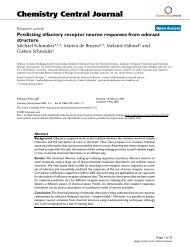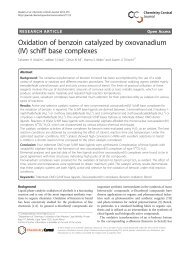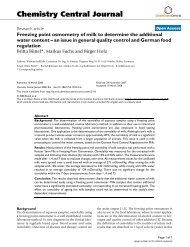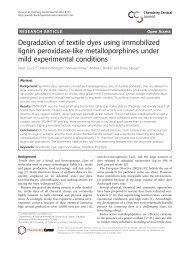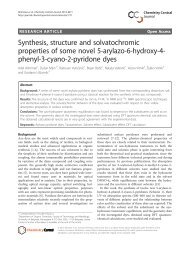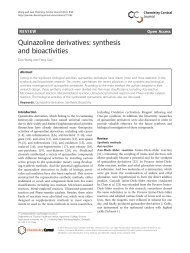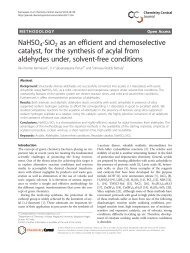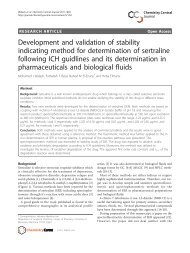Structure and properties of molybdenum oxide nitrides as model ...
Structure and properties of molybdenum oxide nitrides as model ...
Structure and properties of molybdenum oxide nitrides as model ...
Create successful ePaper yourself
Turn your PDF publications into a flip-book with our unique Google optimized e-Paper software.
Kühn et al. Chemistry Central Journal 2011, 5:42<br />
http://journal.chemistrycentral.com/content/5/1/42<br />
RESEARCH ARTICLE Open Access<br />
<strong>Structure</strong> <strong>and</strong> <strong>properties</strong> <strong>of</strong> <strong>molybdenum</strong> <strong>oxide</strong><br />
<strong>nitrides</strong> <strong>as</strong> <strong>model</strong> systems for selective oxidation<br />
catalysts<br />
Sven Kühn, Peter Schmidt-Zhang, Alex<strong>and</strong>er HP Hahn, Manoup Huber, Martin Lerch <strong>and</strong> Thorsten Ressler *<br />
Abstract<br />
Molybdenum <strong>oxide</strong> nitride (denoted <strong>as</strong> Mo(O,N)3) w<strong>as</strong> obtained by ammonolysis <strong>of</strong> a-MoO3 with g<strong>as</strong>eous<br />
ammonia. Electronic <strong>and</strong> geometric structure, reducibility, <strong>and</strong> conductivity <strong>of</strong> Mo(O,N) 3 were investigated by XRD,<br />
XAS, UV-Vis spectroscopy, <strong>and</strong> impedance me<strong>as</strong>urements. Catalytic performance in selective propene oxidation w<strong>as</strong><br />
determined by online m<strong>as</strong>s spectrometry und g<strong>as</strong> chromatography. Upon incorporation <strong>of</strong> nitrogen, Mo(O,N)3<br />
maintained the characteristic layer structure <strong>of</strong> a-MoO3. XRD analysis showed an incre<strong>as</strong>ed structural disorder in<br />
the layers while nitrogen is removed from the lattice <strong>of</strong> Mo(O,N)3 at temperatures above ~600 K. Compared to<br />
regular a-MoO3, Mo(O,N)3 exhibited a higher electronic <strong>and</strong> ionic conductivity <strong>and</strong> an onset <strong>of</strong> reduction in<br />
propene at lower temperatures. Surprisingly, a-MoO3 <strong>and</strong> Mo(O,N)3 exhibited no detectable differences in onset<br />
temperatures <strong>of</strong> propene oxidation <strong>and</strong> catalytic selectivity or activity. Apparently, the incre<strong>as</strong>ed reducibility, oxygen<br />
mobility, <strong>and</strong> conductivity <strong>of</strong> Mo(O,N) 3 compared to a-MoO3 had no effect on the catalytic behavior <strong>of</strong> the two<br />
catalysts. The results presented confirm the suitability <strong>of</strong> <strong>molybdenum</strong> <strong>oxide</strong> <strong>nitrides</strong> <strong>as</strong> <strong>model</strong> systems for studying<br />
bulk contributions to selective oxidation.<br />
Background<br />
Molybdenum <strong>oxide</strong>s are active heterogeneous catalysts<br />
for selective oxidation <strong>of</strong> light alkanes <strong>and</strong> alkenes [1-6].<br />
In addition to catalytic activity <strong>and</strong> long-term stability,<br />
improved selectivity <strong>and</strong> efficient use <strong>of</strong> raw materials<br />
become <strong>of</strong> incre<strong>as</strong>ing importance in industrial applications.<br />
In spite <strong>of</strong> intensive research, structure-reactivity<br />
correlations <strong>and</strong> knowledge about the catalytically active<br />
species remain scarce. Hence, new catalysts are developed<br />
by “trial <strong>and</strong> error” methods. Although this<br />
approach h<strong>as</strong> been successful, it becomes incre<strong>as</strong>ingly<br />
apparent that new ways need to be explored to further<br />
advance the design <strong>of</strong> improved functional materials.<br />
Therefore, a deeper underst<strong>and</strong>ing <strong>of</strong> the correlations<br />
between structure, activity, <strong>and</strong> selectivity will serve <strong>as</strong><br />
the foundation for a knowledge-b<strong>as</strong>ed development <strong>of</strong><br />
new <strong>and</strong> enhanced catalysts.<br />
Selective oxidation <strong>of</strong> alkenes using <strong>molybdenum</strong><br />
<strong>oxide</strong> catalysts is commonly believed to proceed<br />
* Correspondence: thorsten.ressler@tu-berlin.de<br />
Technische Universität Berlin, Institut für Chemie, Sekr. C2, Str<strong>as</strong>se des 17.<br />
Juni 135, D-10623 Berlin, Germany<br />
© 2010 Kühn et al<br />
according to a reduction-oxidation-mechanism [1,4]. In<br />
a first step the reactant partially reduces the metal <strong>oxide</strong><br />
catalyst. Afterwards, the catalyst is re-oxidized by oxygen<br />
from the g<strong>as</strong> ph<strong>as</strong>e. Hence, lattice oxygen <strong>of</strong> the<br />
<strong>molybdenum</strong> <strong>oxide</strong> catalyst is suggested to selectively<br />
oxidize the alkene. Oxidation experiments using 18 O<br />
have verified that lattice oxygen <strong>of</strong> a-MoO 3 is involved<br />
in the catalytic process [7]. Accordingly, mobility <strong>of</strong> oxygen<br />
in the lattice <strong>of</strong> the <strong>oxide</strong> catalyst is expected to<br />
play an important role for catalyst activity <strong>and</strong><br />
selectivity.<br />
Conventional <strong>molybdenum</strong> b<strong>as</strong>ed <strong>oxide</strong> catalysts consist<br />
<strong>of</strong> either binary <strong>molybdenum</strong> <strong>oxide</strong> system or mixed<br />
<strong>oxide</strong>s with additional metal centers. Additional metals<br />
such <strong>as</strong> W, Nb, or V stabilize characteristic crystallographic<br />
structures which lead to oxidation catalysts with<br />
improved activity <strong>and</strong> selectivity [8,9]. However, the<br />
influence <strong>of</strong> structural variety <strong>and</strong> chemical complexity<br />
in the mixed <strong>oxide</strong> systems on catalytic performance is<br />
difficult to distinguish. In order to reduce this inherent<br />
complexity <strong>of</strong> mixed <strong>oxide</strong> catalysts, suitable <strong>model</strong> systems<br />
are sought. In particular with respect to elucidating<br />
the effect <strong>of</strong> oxygen mobility on catalytic performance it
Kühn et al. Chemistry Central Journal 2011, 5:42<br />
http://journal.chemistrycentral.com/content/5/1/42<br />
appears counterproductive to vary chemical composition<br />
<strong>and</strong> <strong>oxide</strong> lattice structure simultaneously. Hence,<br />
instead <strong>of</strong> modifying the cation lattice to affect oxygen<br />
mobility it seems more promising to directly modify the<br />
anion lattice. Ideally however, this modification should<br />
have little influence on the long-range order crystallographic<br />
structure <strong>of</strong> the catalyst.<br />
Along that line, metal <strong>oxide</strong> <strong>nitrides</strong> appear to be suitable<br />
<strong>model</strong> systems. In many c<strong>as</strong>es nitrogen can be<br />
incorporated in the <strong>oxide</strong> lattice <strong>of</strong> a particular metal<br />
<strong>oxide</strong> without changing the crystallographic structure<br />
[10,11]. Alternatively, met<strong>as</strong>table <strong>and</strong> previously not<br />
available <strong>oxide</strong> structures can be obtained without changing<br />
the cation composition [12,13]. Both approaches<br />
may result in suitable <strong>model</strong> systems for selective oxidation<br />
catalysts. Zirconium <strong>oxide</strong> <strong>nitrides</strong>, for instance,<br />
have been shown to be active catalysts for ammonia<br />
decomposition [14]. It is suggested, however, that in<br />
these materials the nitrogen atoms not only affect anion<br />
mobility but also directly participate in the catalytic<br />
reaction.<br />
In this work we have chosen <strong>molybdenum</strong> tri<strong>oxide</strong> in<br />
the orthorhombic a-MoO 3 modification <strong>as</strong> well-known<br />
<strong>model</strong> system for selective propene oxidation catalysts.<br />
a-MoO 3 is transformed into the corresponding <strong>molybdenum</strong><br />
<strong>oxide</strong> nitride by reaction with g<strong>as</strong>eous ammonia.<br />
Subsequently, the thus obtained <strong>model</strong> catalyst is used<br />
to reveal correlations between lattice oxygen availability,<br />
electrical <strong>properties</strong>, <strong>and</strong> catalytic activity <strong>and</strong> selectivity<br />
in selective propene oxidation.<br />
Results <strong>and</strong> Discussion<br />
Structural characterization <strong>of</strong> Mo(O,N) 3<br />
Geometric <strong>and</strong> electronic structure <strong>of</strong> Mo(O,N) 3 <strong>and</strong><br />
reference a-MoO 3 were investigated by XRD, XAS, <strong>and</strong><br />
DR-UV-Vis spectroscopy. The aim <strong>of</strong> these studies w<strong>as</strong><br />
to reveal significant differences in structural <strong>and</strong> electronic<br />
<strong>properties</strong> <strong>of</strong> the two materials to be used <strong>as</strong> <strong>model</strong><br />
systems for oxidation catalysts. Interestingly, incorporation<br />
<strong>of</strong> nitrogen in a-MoO 3 resulted in a pronounced<br />
color change <strong>of</strong> the material. In contr<strong>as</strong>t to the lightgrey<br />
color <strong>of</strong> a-MoO 3,Mo(O,N) 3 exhibited a dark-blue<br />
color. This color change, however, cannot be attributed<br />
to a significant reduction <strong>of</strong> MoO 3 to MoO 2 (< 5%).<br />
XRD patterns <strong>and</strong> XAS spectra <strong>of</strong> a-MoO3 <strong>and</strong> Mo(O,<br />
N)3 are shown in Figure 1 <strong>and</strong> Figure 2, respectively.<br />
The XRD pattern <strong>and</strong> the XANES <strong>and</strong> EXAFS spectra<br />
<strong>of</strong> Mo(O,N) 3 are similar to those <strong>of</strong> a-MoO 3 without<br />
additional ph<strong>as</strong>es detectable. Crystallite size <strong>of</strong> a-MoO 3<br />
amounted to ~ 60 nm <strong>as</strong> calculated from the integral<br />
breadths <strong>of</strong> XRD peaks using the Scherrer equation [15].<br />
Apparently, the long-range order <strong>and</strong> short-range order<br />
structure <strong>of</strong> a-MoO3 is preserved after incorporation <strong>of</strong><br />
nitrogen. Despite the overall agreement, subtle<br />
Page 2 <strong>of</strong> 10<br />
differences can be seen in the XRD patterns <strong>and</strong> XAS<br />
data <strong>of</strong> a-MoO3 <strong>and</strong> Mo(O,N) 3. An incre<strong>as</strong>ed XRD peak<br />
broadening (Figure 1) <strong>and</strong> a reduced XAFS amplitude<br />
(Figure 2) indicate an incre<strong>as</strong>ed formation <strong>of</strong> defects in<br />
the Mo(O,N)3 structure upon nitridation. It is suggested<br />
that nitrogen atoms substitute for oxygen in the layers<br />
<strong>of</strong> a-MoO3 leading to an incre<strong>as</strong>ed strain <strong>and</strong> a corresponding<br />
peak broadening in the XRD pattern. Similarly,<br />
an incre<strong>as</strong>ed distance distribution around the Mo centers<br />
in Mo(O,N) 3 resulted in the XAFS amplitude reduction<br />
observed. Moreover, analysis <strong>of</strong> the Mo K edge shift<br />
revealed an average valence <strong>of</strong> +5.86 for Mo(O,N) 3 <strong>and</strong><br />
+5.96 for the a-MoO3 used <strong>as</strong> reference [16]. According<br />
to the simplified defect <strong>model</strong> <strong>as</strong>sumed incorporation <strong>of</strong><br />
nitrogen results in formation <strong>of</strong> vacancies in the anion<br />
lattice (3O x O +2NH3→2N ’ O +V◦◦ O +3H2O). Therefore,<br />
the slight reduction in Mo average valence should not<br />
be related to the presence <strong>of</strong> nitrogen but rather originate<br />
from a slight reduction <strong>of</strong> a-MoO3 by g<strong>as</strong>eous<br />
ammonia during sample preparation. However, the corresponding<br />
5% MoO2 were not detectable in the XRD<br />
or XAFS data <strong>of</strong> Mo(O,N) 3.<br />
Absorption edge energies in the UV-Vis range <strong>as</strong><br />
determined by DR-UV-Vis spectroscopy (Figure 1)<br />
amounted to 3.3 eV for a-MoO3 <strong>and</strong> 2.8 eV for Mo(O,<br />
N) 3. Inter-valence transitions in the range from 1 - 3 eV<br />
in the UV-Vis spectrum <strong>of</strong> a-MoO3 corroborated the<br />
reduced average valence <strong>of</strong> 5.96 <strong>and</strong> the light-gray color<br />
<strong>of</strong> the reference a-MoO3 [17]. The dark-blue color <strong>of</strong><br />
Mo(O,N) 3 is suggested to originate from the formation<br />
<strong>of</strong> color centers accompanying the incorporation <strong>of</strong><br />
nitrogen in the oxygen lattice. A similar effect h<strong>as</strong> been<br />
described for intensely colored zirconium <strong>oxide</strong> <strong>nitrides</strong><br />
compared to colorless ZrO2 [18].<br />
Thermal stability <strong>of</strong> Mo(O,N) 3<br />
After confirming that the long-range structure <strong>of</strong> a-<br />
MoO 3 persisted after incorporation <strong>of</strong> nitrogen, thermal<br />
stability <strong>of</strong> Mo(O,N) 3 w<strong>as</strong> studied prior to aiming at correlations<br />
between oxygen mobility <strong>and</strong> catalytic <strong>properties</strong>.<br />
Therefore, in situ XRD patterns <strong>of</strong> Mo(O,N) 3 were<br />
me<strong>as</strong>ured under oxidative reaction conditions (5% O 2 in<br />
He). Figure 3 shows the evolution <strong>of</strong> XRD patterns <strong>of</strong><br />
Mo(O,N)3 in the temperature range from 473 K to 773<br />
K. The XRD patterns <strong>of</strong> Mo(O,N) 3 exhibited an incre<strong>as</strong>ing<br />
peak intensity <strong>and</strong> decre<strong>as</strong>ing peak-broadening with<br />
incre<strong>as</strong>ing reaction temperature. Conversely, the XRD<br />
patterns <strong>of</strong> a-MoO 3 showed no significant changes during<br />
thermal treatment in oxygen. For a more detailed<br />
analysis, evolution <strong>of</strong> the integral breadth determined<br />
from the 110, 101, <strong>and</strong> 020 reflections <strong>of</strong> a-MoO3 <strong>and</strong><br />
Mo(O,N)3 is shown in Figure 3. Only minor changes<br />
were detectable for a-MoO 3. Conversely, above ~623 K<br />
the integral breadth determined for Mo(O,N) 3 changed
Kühn et al. Chemistry Central Journal 2011, 5:42<br />
http://journal.chemistrycentral.com/content/5/1/42<br />
Figure 1 XRD patterns (top) <strong>and</strong> DR-UV-Vis absorption spectra<br />
(bottom) <strong>of</strong> a-MoO3 <strong>and</strong> Mo(O,N)3.<br />
dramatically while the effect decre<strong>as</strong>ed going from 020<br />
to 110 <strong>and</strong> 101. Variations in integral breadth can be<br />
attributed to changes in crystallite size, strain, or disorder.<br />
Because <strong>of</strong> the characteristic evolution <strong>of</strong> integral<br />
breadth with temperature <strong>as</strong> depicted in Figure 3 the<br />
changes observed were interpreted in terms <strong>of</strong> varying<br />
disorder in the crystallites <strong>of</strong> Mo(O,N) 3. Apparently, at<br />
temperatures above ~623 K nitrogen w<strong>as</strong> removed from<br />
the <strong>molybdenum</strong> <strong>oxide</strong> lattice. This w<strong>as</strong> accompanied by<br />
a reduced defect density in the layers <strong>of</strong> Mo(O,N)3<br />
whichcorrespondstothemorepronouncedchangein<br />
peak-width <strong>of</strong> the 020 peak compared to 110 or 101<br />
(Figure 3). Above 700 K the integral breadths <strong>of</strong> thermally<br />
treated Mo(O,N) 3 became similar to those <strong>of</strong> a-<br />
MoO 3. This indicates the largely reversible incorporation<br />
<strong>and</strong> removal <strong>of</strong> nitrogen from the <strong>oxide</strong> layer structure<br />
<strong>of</strong> a-MoO 3. Furthermore, evolution <strong>of</strong> DR-UV-Vis<br />
spectra <strong>of</strong> Mo(O,N)3 during thermal treatment in oxygen<br />
revealed an incre<strong>as</strong>e <strong>of</strong> the absorption edge energy<br />
above ~623 K. Again the final edge energy above 700 K<br />
corresponded to that <strong>of</strong> a-MoO 3. Eventually, Mo(O,N) 3<br />
samples subjected to thermal treatment at 673 K in various<br />
in situ experiments exhibited a remaining nitrogen<br />
Page 3 <strong>of</strong> 10<br />
Figure 2 XANES spectra <strong>of</strong> a-MoO3 <strong>and</strong> Mo(O,N)3 at 298 K<br />
(top) <strong>and</strong> Fourier transformed c(k) <strong>of</strong> a-MoO 3 <strong>and</strong> Mo(O,N) 3<br />
(before <strong>and</strong> after catalysis) (bottom).<br />
content <strong>of</strong> about 25% <strong>of</strong> the original amount. Hence, it<br />
w<strong>as</strong> concluded that Mo(O,N) 3 constitutes a suitable<br />
<strong>model</strong> system for correlating structural <strong>and</strong> functional<br />
<strong>properties</strong> <strong>of</strong> an anion-lattice modified Mo <strong>oxide</strong> catalyst<br />
at temperatures below 673 K.<br />
Reducibility <strong>of</strong> a-MoO 3 <strong>and</strong> Mo(O,N) 3<br />
According to the redox mechanism for selective oxidation<br />
reactions, availability <strong>of</strong> lattice oxygen to the g<strong>as</strong>eous<br />
reactants appears to be an important parameter for<br />
activity <strong>and</strong> selectivity <strong>of</strong> oxidation catalysts. Hence,<br />
temperature-programmed reduction is a common<br />
method to investigate <strong>and</strong> compare metal <strong>oxide</strong> catalysts.<br />
Here, the reduction behavior <strong>of</strong> a-MoO 3 <strong>and</strong> Mo<br />
(O,N) 3 w<strong>as</strong> studied in situ by XRD, XAS, <strong>and</strong> DR-UV-<br />
Vis spectroscopy. As reported previously, a-MoO3 is<br />
readily reduced to MoO2 in 5% propene at temperatures<br />
above ~ 650 K [16,19-21]. Besides the formation <strong>of</strong><br />
shear-structural defects in the a-MoO 3 layers, no<br />
ordered intermediate ph<strong>as</strong>es are detectable during<br />
reduction. Similar to these previous reports reduction <strong>of</strong><br />
both Mo(O,N) 3 <strong>and</strong> a-MoO 3 to MoO 2 w<strong>as</strong> observed by
Kühn et al. Chemistry Central Journal 2011, 5:42<br />
http://journal.chemistrycentral.com/content/5/1/42<br />
Figure 3 Evolution <strong>of</strong> XRD patterns during thermal treatment<br />
<strong>of</strong> Mo(O,N)3 (473 - 773 K, 5% O2 in He) <strong>and</strong> integral breadth<br />
calculated for reflections 020 (rectangles), 110 (circles), <strong>and</strong><br />
101 (triangles) <strong>of</strong> a-MoO 3 <strong>and</strong> Mo(O,N) 3.<br />
in situ XRD <strong>and</strong> XAS. However, analysis <strong>of</strong> Mo K edge<br />
position <strong>and</strong> evolution <strong>of</strong> g<strong>as</strong>eous products revealed a<br />
much improved reducibility <strong>of</strong> Mo(O,N) 3 (Figure 4).<br />
Apparently, the presence <strong>of</strong> nitrogen in the a-MoO3 layers resulted in an onset temperature <strong>of</strong> ~ 660 K for<br />
Mo(O,N)3 compared to ~ 700 K for a-MoO3. Given the<br />
nearly identical long-range order structures, crystallite<br />
sizes, <strong>and</strong> morphologies <strong>of</strong> a-MoO3 <strong>and</strong> Mo(O,N) 3,the<br />
better reducibility <strong>of</strong> Mo(O,N) 3 h<strong>as</strong> to be attributed to<br />
an incre<strong>as</strong>ed oxygen mobility in the defect-rich layers <strong>of</strong><br />
Mo(O,N) 3. The higher oxygen mobility <strong>of</strong> Mo(O,N) 3<br />
compared to a-MoO3 may be caused by oxygen vacancies<br />
formed during incorporation <strong>of</strong> nitrogen in a-<br />
MoO3 according to 3O x O +2NH3→2N ’ O +V◦◦ O +3H2O.<br />
Eventually, the treatment <strong>of</strong> Mo(O,N) 3 at temperatures<br />
above750Kresultedintheremoval<strong>of</strong>nitrogenfrom<br />
the <strong>oxide</strong> layers. Upon re-oxidation to MoO3 both materials<br />
exhibited the same reduction behavior.<br />
Electrical <strong>properties</strong> <strong>of</strong> Mo(O,N) 3<br />
Incorporation <strong>of</strong> nitrogen in the layer structure <strong>of</strong> a-<br />
MoO3 should have a pronounced effect on the electrical<br />
<strong>properties</strong> <strong>of</strong> Mo(O,N) 3 (i.e. both electronic <strong>and</strong> ionic<br />
conductivity). Conductivity <strong>of</strong> a-MoO 3 <strong>and</strong> Mo(O,N) 3<br />
w<strong>as</strong> studied by impedance spectroscopy. At 300 K the<br />
conductivity <strong>of</strong> Mo(O,N) 3 exceeded that <strong>of</strong> a-MoO 3 by<br />
Page 4 <strong>of</strong> 10<br />
Figure 4 Evolution <strong>of</strong> Mo K edge shift during reduction <strong>of</strong> a-<br />
MoO3 (solid line) <strong>and</strong> Mo(O,N)3 (d<strong>as</strong>hed line) (300 K - 773 K,<br />
5% propene in He) <strong>and</strong> corresponding ion currents <strong>of</strong> water<br />
<strong>and</strong> acrolein.<br />
a factor <strong>of</strong> 500. Unfortunately, the set-up used did not<br />
permit to distinguish between electronic <strong>and</strong> ionic conductivity<br />
in a mixed conductor such <strong>as</strong> a-MoO 3. Hence,<br />
the dominating conduction process at a given temperature<br />
w<strong>as</strong> concluded from the corresponding activation<br />
energy obtained from temperature-dependent impedance<br />
me<strong>as</strong>urements. As an example, Figure 5 shows<br />
the Nyquist presentation <strong>of</strong> impedance me<strong>as</strong>urements <strong>of</strong><br />
a-MoO3 in the temperature range from 524 K to 834 K.<br />
The decre<strong>as</strong>ing diameter <strong>of</strong> the semi-circles corresponds<br />
to a decre<strong>as</strong>ing resistance with incre<strong>as</strong>ing temperature.<br />
Evolution <strong>of</strong> the resistance <strong>of</strong> Mo(O,N) 3 during thermal<br />
treatmentinairisshowninFigure5.Above600KMo<br />
(O,N) 3 exhibited an incre<strong>as</strong>ing resistance. Eventually, at<br />
temperatures above 700 K the thermally treated Mo(O,<br />
N)3 showedthesameresistance<strong>as</strong>a-MoO3. Thistemperature<br />
range coincides with the onset <strong>of</strong> oxygen mobility<br />
above 600 K <strong>and</strong> the removal <strong>of</strong> nitrogen from Mo<br />
(O,N) 3 between600K<strong>and</strong>700Kfollowedbyformation<br />
<strong>of</strong> regular a-MoO 3.Hence,theevolution<strong>of</strong>electrical<br />
<strong>properties</strong> <strong>of</strong> Mo(O,N) 3 is in good agreement with the
Kühn et al. Chemistry Central Journal 2011, 5:42<br />
http://journal.chemistrycentral.com/content/5/1/42<br />
Figure 5 Nyquist presentation <strong>of</strong> impedance me<strong>as</strong>urements <strong>of</strong><br />
a-MoO 3 (top) at selected temperatures between 524 K <strong>and</strong><br />
659 K <strong>and</strong> evolution <strong>of</strong> resistances <strong>of</strong> a-MoO3 <strong>and</strong> Mo(O,N)3<br />
with incre<strong>as</strong>ing temperature (bottom).<br />
structural changes occurring between 600 K <strong>and</strong> 700 K<br />
(Figure 3).<br />
From an Arrhenius type presentation <strong>of</strong> the conductivity<br />
<strong>as</strong> a function <strong>of</strong> temperature, the activation energies<br />
<strong>of</strong> the corresponding dominating processes can be<br />
obtained. a-MoO 3 showed two different extrinsic conduction<br />
processes with activation energies <strong>of</strong> 0.22 eV<br />
<strong>and</strong> 0.77 eV below 773 K (Figure 6). These values agree<br />
with previous reports [22] <strong>and</strong> have been <strong>as</strong>signed to<br />
electronic <strong>and</strong> structural defects in a-MoO 3 (0.22 eV)<br />
<strong>and</strong> oxygen mobility at temperatures above 639 K (0.77<br />
eV). Above 773 K an activation energy <strong>of</strong> 1.56 eV w<strong>as</strong><br />
found. With respect to the b<strong>and</strong> gap energy <strong>of</strong> a-MoO 3<br />
<strong>of</strong> 3.3 eV, this activation energy is <strong>as</strong>signed to intrinsic<br />
conduction <strong>of</strong> MoO 3. At temperatures below 500 K Mo<br />
(O,N)3 showed two activation energies <strong>of</strong> different<br />
extrinsic conduction processes (Figure 6). Because <strong>of</strong> the<br />
beginning <strong>and</strong> rather continuous reaction <strong>of</strong> Mo(O,N) 3<br />
to a-MoO 3 at temperatures above 500 K, no reliable<br />
activation energies could be obtained in this temperature<br />
range.<br />
Page 5 <strong>of</strong> 10<br />
Figure 6 Arrhenius type presentation <strong>of</strong> conductivity <strong>of</strong> a-<br />
MoO 3 (top) <strong>and</strong> Mo(O,N) 3 (bottom). Activation energies <strong>of</strong> various<br />
conduction processes are indicated.<br />
Functional <strong>and</strong> structural characterization <strong>of</strong> Mo(O,N) 3<br />
under catalytic conditions<br />
Functional characterization <strong>of</strong> Mo(O,N) 3 <strong>and</strong> a-MoO 3<br />
in selective propene oxidation w<strong>as</strong> conducted simultaneously<br />
with in situ structural UV-Vis <strong>and</strong> XAS me<strong>as</strong>urements.<br />
For a sufficient time-resolution, the g<strong>as</strong><br />
ph<strong>as</strong>e composition w<strong>as</strong> qualitatively analyzed by a noncalibrated<br />
m<strong>as</strong>s spectrometer. Time-resolved me<strong>as</strong>urements<br />
were required because <strong>of</strong> the ongoing nitrogen<br />
removal from Mo(O,N) 3 at temperatures above 600 K.<br />
Prolonged experiments under steady-state conditions<br />
mayhavebeenpronetomissingminordifferencesin<br />
the performance <strong>of</strong> the catalysts. Repeated quantitative<br />
me<strong>as</strong>urements <strong>of</strong> the g<strong>as</strong> ph<strong>as</strong>e composition under<br />
selective oxidation reaction conditions were performed<br />
by g<strong>as</strong> chromatography at selected temperatures.<br />
Evolution <strong>of</strong> Mo K edge Fourier transformed c(k) <strong>of</strong><br />
a-MoO 3 <strong>and</strong> Mo(O,N) 3 me<strong>as</strong>ured during thermal treatment<br />
in 5% propene <strong>and</strong> 5% oxygen in the temperature<br />
range from 300 K to 723 K is depicted in Figure 7. In<br />
the first run, besides minor differences in the spectra <strong>of</strong><br />
the starting materials, a-MoO3 <strong>and</strong> Mo(O,N)3 exhibited
Kühn et al. Chemistry Central Journal 2011, 5:42<br />
http://journal.chemistrycentral.com/content/5/1/42<br />
Figure 7 Evolution <strong>of</strong> Fourier transformed c(k) <strong>of</strong> a-MoO3 (top)<br />
<strong>and</strong> Mo(O,N) 3 (bottom) during treatment in 5% propene <strong>and</strong><br />
5% oxygen in the temperature range from 300 K to 723 K.<br />
a similar evolution. The reduction in amplitude w<strong>as</strong><br />
mainly caused by the incre<strong>as</strong>ing reaction temperature.<br />
During a second thermal treatment under reaction conditions<br />
<strong>and</strong>, hence, after removal <strong>of</strong> nitrogen above 600<br />
K, both samples showed the same structural evolution.<br />
Moreover, the Mo K edge position <strong>of</strong> a-MoO 3 showed<br />
Page 6 <strong>of</strong> 10<br />
no significant change during treatment in propene <strong>and</strong><br />
oxygen. Conversely, above ~600 K the Mo K edge position<br />
<strong>of</strong> Mo(O,N) 3 continuously shifted to higher energies<br />
with incre<strong>as</strong>ing temperature. This behavior is again<br />
correlated to the removal <strong>of</strong> nitrogen at temperatures<br />
above ~ 600 K. During the second run the edge position<br />
remained at a constant value, similar to that <strong>of</strong> a-<br />
MoO 3. Hence, evolution <strong>of</strong> the local geometric <strong>and</strong> electronic<br />
structure revealed that removal <strong>of</strong> nitrogen from<br />
Mo(O,N) 3 under propene oxidation conditions resulted<br />
in regular a-MoO 3 exhibiting the same structural <strong>and</strong><br />
electronic <strong>properties</strong> <strong>as</strong> the starting a-MoO 3 material.<br />
This is in good agreement with the in situ XRD me<strong>as</strong>urements<br />
described above (Figure 3).<br />
As to the catalytic <strong>properties</strong> <strong>of</strong> a-MoO 3 <strong>and</strong> Mo(O,<br />
N) 3, evolution <strong>of</strong> propene oxidation products acrolein<br />
<strong>and</strong> CO 2 during two consecutive treatments is depicted<br />
in Figure 8. Apparently, under propene oxidation conditions<br />
both materials exhibited a very similar behavior<br />
already during the first treatment. Thus, no significant<br />
differences in onset temperature or product evolution<br />
were detectable. In spite <strong>of</strong> their significantly different<br />
structural <strong>and</strong> electronic characteristics (reducibility <strong>and</strong><br />
conductivity) both sample showed a nearly identical catalytic<br />
performance.<br />
In situ DR-UV-Vis experiments under propene oxidation<br />
conditions were performed in a temperature range<br />
from 298 K to 700 K during two consecutive runs. Evolution<br />
<strong>of</strong> DR-UV-Vis spectra <strong>of</strong> a-MoO3 <strong>and</strong> Mo(O,N)3<br />
is depicted in Figure 9. Above 4 eV the two series exhibited<br />
a very similar behavior. This corresponded to only<br />
Figure 8 Ion currents (CO 2 <strong>and</strong> acrolein) me<strong>as</strong>ured during in situ XAFS studies on a-MoO 3 (red) <strong>and</strong> Mo(O,N) 3 (black) (Figure 7) in 5%<br />
propene <strong>and</strong> 5% oxygen in the temperature range from 300 K to 723 K.
Kühn et al. Chemistry Central Journal 2011, 5:42<br />
http://journal.chemistrycentral.com/content/5/1/42<br />
Figure 9 In situ DR-UV-Vis absorption spectra <strong>of</strong> a-MoO3 <strong>and</strong><br />
Mo(O,N)3 me<strong>as</strong>ured during two consecutive treatments in 5%<br />
propene <strong>and</strong> 5% O 2 in the temperature range from 300 K to<br />
700 K.<br />
minor structural changes in both MoO 3 type materials<br />
under catalytic reaction conditions. Conversely, below<br />
the absorption edge at about 3.5 eV Mo(O,N)3 showed a<br />
more pronounced change in the DR-UV-Vis spectra<br />
with temperature. This change corresponded to the<br />
removal <strong>of</strong> nitrogen at temperatures above ~600 K <strong>and</strong><br />
the accompanying modification <strong>of</strong> the electronic structure<br />
<strong>of</strong> Mo(O,N) 3. Accordingly, the UV-Vis spectrum <strong>of</strong><br />
Mo(O,N) 3 after thermal treatment became more similar<br />
to that <strong>of</strong> regular a-MoO3. The apparent differences<br />
between the spectra <strong>of</strong> both catalysts after thermal treatment<br />
can be <strong>as</strong>cribed to a residual amount <strong>of</strong> nitrogen<br />
in the oxygen lattice <strong>of</strong> Mo(O,N) 3.Overall,thestructural<br />
changes observed in the evolution <strong>of</strong> UV-Vis spectra<br />
(Figure 9) were similar to the results <strong>of</strong> in situ XAS<br />
or XRD experiments <strong>as</strong> described above (Figure 3 <strong>and</strong><br />
Figure 7). Apparently, in situ bulk structural studies on<br />
Mo(O,N)3 <strong>and</strong> a-MoO3 resulted in nearly the same<br />
short-range to medium-range structure after catalysis<br />
experiments. Conversely, UV-Vis spectroscopy proved<br />
to be more sensitive to minor electronic effects <strong>of</strong> nitrogen<br />
residuals in Mo(O,N) 3 after thermal treatment.<br />
Page 7 <strong>of</strong> 10<br />
The corresponding evolution <strong>of</strong> MS ion currents <strong>of</strong><br />
acrolein <strong>and</strong> CO 2 me<strong>as</strong>ured during treatment <strong>of</strong> a-<br />
MoO 3 <strong>and</strong> Mo(O,N) 3 in propene <strong>and</strong> oxygen from 300<br />
K to 700 K is depicted in Figure 10. Apparently, during<br />
two consecutive treatments both catalysts exhibited the<br />
same onset <strong>of</strong> catalytic activity <strong>and</strong> the same qualitative<br />
evolution <strong>of</strong> catalytic performance. As stated above, no<br />
effect <strong>of</strong> the pronounced geometric <strong>and</strong> electronic differences<br />
between a-MoO 3 <strong>and</strong> Mo(O,N) 3 w<strong>as</strong> detectable<br />
in the evolution <strong>of</strong> g<strong>as</strong>eous oxidation products during<br />
catalytic testing. The presence<strong>of</strong>nitrogeninMo(O,N) 3<br />
<strong>and</strong> the removal <strong>of</strong> a large fraction <strong>of</strong> nitrogen from Mo<br />
(O,N)3 during treatment at temperatures above ~600 K<br />
did not result in detectable differences in catalytic<br />
behavior.<br />
In addition to time-resolved MS me<strong>as</strong>urement during<br />
catalytic testing, the g<strong>as</strong> ph<strong>as</strong>e composition at selected<br />
temperatures w<strong>as</strong> quantitatively analyzed by g<strong>as</strong> chromatography.<br />
Conversion <strong>of</strong> propene <strong>and</strong> product selectivity<br />
to acrolein, CO 2, <strong>and</strong> CO at 655 K <strong>and</strong> 700 K <strong>of</strong><br />
a-MoO3 <strong>and</strong> Mo(O,N)3 are shown in Figure 11. Under<br />
the reaction conditions chosen, a-MoO3 <strong>and</strong> Mo(O,N)3<br />
exhibited an average propene conversion <strong>of</strong> 1.1% or<br />
2.2%, <strong>and</strong> 1.1% or 2.5%, respectively. Additionally, a-<br />
MoO 3 <strong>and</strong> Mo(O,N) 3 exhibited nearly the same product<br />
selectivities at the reaction temperatures used. As<br />
already observed in the time-resolved me<strong>as</strong>urements,<br />
also under steady-state conditions the presence <strong>of</strong> nitrogen<br />
in Mo(O,N)3 did not result in significant differences<br />
in catalytic behavior compared to a-MoO3.<br />
Conclusions<br />
Eventually, structure function correlations <strong>of</strong> Mo(O,N) 3<br />
can be concluded from the described investigations.<br />
Characterization <strong>of</strong> electronic <strong>and</strong> geometric structure<br />
<strong>as</strong> well <strong>as</strong> reducibility <strong>of</strong> Mo(O,N) 3 resulted in a pronounced<br />
influence <strong>of</strong> the incorporation <strong>of</strong> nitrogen in<br />
the layer structure <strong>of</strong> a-MoO3 (Figure 1 - Figure 4).<br />
Compared to regular a-MoO 3,Mo(O,N) 3 exhibited a<br />
much incre<strong>as</strong>ed electronic <strong>and</strong> ionic conductivity (Figure<br />
5). The latter afforded a lowering <strong>of</strong> the onset <strong>of</strong> reduction<br />
<strong>of</strong> Mo(O,N) 3 by about 40 K (Figure 4). Structural<br />
studies at elevated temperatures showed that nitrogen is<br />
removed from the <strong>oxide</strong> lattice <strong>of</strong> Mo(O,N) 3 above ~600<br />
K. The thus obtained MoO3 exhibited again the same<br />
short-range <strong>and</strong> long-range structural characteristics <strong>as</strong><br />
the parent a-MoO 3 material (Figure 3 <strong>and</strong> Figure 7).<br />
Nevertheless, in spite <strong>of</strong> these characteristic differences<br />
between the a-MoO 3 <strong>and</strong> Mo(O,N) 3 used, both materials<br />
exhibited no detectable differences in their catalytic<br />
behavior. Neither studying onset temperatures by timeresolved<br />
methods (Figure 8 <strong>and</strong> Figure 10) nor me<strong>as</strong>uring<br />
conversion or selectivity under steady-state conditions<br />
(Figure 11) revealed a pronounced influence <strong>of</strong> the
Kühn et al. Chemistry Central Journal 2011, 5:42<br />
http://journal.chemistrycentral.com/content/5/1/42<br />
incorporation <strong>of</strong> nitrogen in the <strong>oxide</strong> lattice on catalytic<br />
<strong>properties</strong>.<br />
In the conventional reduction-oxidation mechanism<br />
for selective oxidation reactions the reactant is oxidized<br />
by nucleophilic lattice oxygen. This way, oxygen vacancies<br />
in the <strong>oxide</strong> lattice are generated at the surface <strong>of</strong><br />
the catalyst. Subsequently, these vacancies are supposed<br />
to be re-filled by diffusion <strong>of</strong> oxygen from the bulk <strong>of</strong><br />
the <strong>oxide</strong> catalyst to its surface. Desorption <strong>of</strong> products<br />
terminates the catalytic cycle <strong>and</strong> frees the active site for<br />
the next reactant molecule. Eventually, the catalyst<br />
needs to be re-oxidized by g<strong>as</strong> ph<strong>as</strong>e oxygen to prevent<br />
deep-reduction <strong>and</strong> deactivation. However, if in fact diffusion<br />
<strong>of</strong> oxygen w<strong>as</strong> required toreplenishtheoxygen<br />
reservoir at the catalyst surface, influencing the mobility<br />
<strong>of</strong> oxygen in the catalyst bulk structure should have a<br />
distinct influence on its catalytic <strong>properties</strong>. The results<br />
presented here suggest that at le<strong>as</strong>t for a-MoO3 in propene<br />
oxidation this is not the c<strong>as</strong>e. Apparently, varying<br />
oxygen mobility h<strong>as</strong> no detectable effect on the catalytic<br />
performance <strong>of</strong> a-MoO 3.Thisimpliesthatifoxygen<br />
vacancies are generated at the surface <strong>of</strong> the catalyst by<br />
reaction with propene, these vacancies will be directly<br />
filled by g<strong>as</strong> ph<strong>as</strong>e reaction without requiring diffusion<br />
<strong>of</strong> oxygen from the bulk. Hence, the similar catalytic<br />
behavior <strong>of</strong> a-MoO3 <strong>and</strong> Mo(O,N)3 may be attributed<br />
to similar surface structures forming on both materials<br />
under reaction conditions. This may underline the<br />
importance <strong>of</strong> the particular structure <strong>and</strong> composition<br />
<strong>of</strong> the surface rather than optimized bulk <strong>properties</strong> <strong>of</strong><br />
selective oxidation catalysts. However, the bulk<br />
Page 8 <strong>of</strong> 10<br />
Figure 10 Ion currents (CO 2 <strong>and</strong> acrolein) me<strong>as</strong>ured during two consecutive treatments <strong>of</strong> a-MoO 3 (red) <strong>and</strong> Mo(O,N) 3 (black) (Figure<br />
9) in 5% propene <strong>and</strong> 5% oxygen in the temperature range from 300 K to 700 K.<br />
structural characterization techniques employed here do<br />
not permit further conclusions <strong>as</strong> to the surface structures<br />
<strong>of</strong> the materials. Moreover, whether activation <strong>and</strong><br />
oxidation <strong>of</strong> propene, <strong>and</strong> activation <strong>of</strong> g<strong>as</strong> ph<strong>as</strong>e oxygen<br />
occur simultaneously or in consecutive steps can only be<br />
speculated. However, it appears that a conventional<br />
Langmuir-Hinshelwood type mechanism may sufficiently<br />
describe propene oxidation on a-MoO 3 without requiring<br />
a particular contribution from the catalyst bulk.<br />
In summary, the results presented here confirm the<br />
suitability <strong>of</strong> <strong>molybdenum</strong> <strong>oxide</strong> <strong>nitrides</strong> <strong>as</strong> <strong>model</strong> systems<br />
for studying bulk contributions to selective alkene<br />
oxidation. With regular a-MoO 3, incorporation <strong>of</strong> nitrogen<br />
permits to significantly <strong>and</strong> reversibly modify electronic<br />
<strong>properties</strong> <strong>and</strong> bulk oxygen mobility. Nitrogen<br />
can be conveniently removed from the <strong>oxide</strong> lattice by<br />
thermal treatment resulting in the original starting<br />
material. Hence, catalytic <strong>properties</strong> <strong>of</strong> the materials<br />
with <strong>and</strong> without nitrogen in the <strong>oxide</strong> lattice can readily<br />
be probed by consecutive experiments. Future studies<br />
on mixed <strong>molybdenum</strong> <strong>oxide</strong> <strong>nitrides</strong> will be employed<br />
to confirm both their applicability <strong>as</strong> <strong>model</strong> systems <strong>and</strong><br />
our conclusions regarding correlations between catalytic<br />
performance <strong>and</strong> electrical <strong>properties</strong> <strong>of</strong> <strong>oxide</strong> catalysts.<br />
Experimental<br />
Preparation <strong>of</strong> <strong>molybdenum</strong> <strong>oxide</strong> nitride<br />
Molybdenum <strong>oxide</strong> nitride (in the following denoted <strong>as</strong><br />
Mo(O,N) 3) w<strong>as</strong> prepared by reaction <strong>of</strong> g<strong>as</strong>eous ammonia<br />
with commercial a-MoO 3 (Chempur). Ammonolysis<br />
w<strong>as</strong> performed in a conventional tube furnace using a
Kühn et al. Chemistry Central Journal 2011, 5:42<br />
http://journal.chemistrycentral.com/content/5/1/42<br />
Figure 11 Propene conversion <strong>and</strong> selectivity <strong>of</strong> a-MoO3 (top)<br />
und Mo(O,N) 3 (bottom) in 5% propene <strong>and</strong> 5% oxygen at 655<br />
K (me<strong>as</strong>urements 1-5) <strong>and</strong> 700 K (me<strong>as</strong>urements 6-10).<br />
silica tube <strong>and</strong> direct g<strong>as</strong> supply[23]. After drying at<br />
383 K in air, a-MoO3 w<strong>as</strong> reacted to Mo(O,N)3 at 548<br />
KwithanNH 3 flow <strong>of</strong> 10 l/h for 10 h. These particular<br />
conditions had been optimized in respect to a maximum<br />
concentration <strong>of</strong> incorporated nitrogen in MoO 3<br />
without a detectable amount <strong>of</strong> rutile-type MoO 2 or<br />
Mo(O,N) 2. Incre<strong>as</strong>ing the temperature, the presence <strong>of</strong><br />
such ph<strong>as</strong>es w<strong>as</strong> clearly detected using X-ray powder<br />
diffraction. With decre<strong>as</strong>ing temperature the nitrogen<br />
content <strong>of</strong> the MoO3 ph<strong>as</strong>e strongly decre<strong>as</strong>ed. Quantitative<br />
nitrogen/oxygen analysis w<strong>as</strong> carried out using<br />
the well-established hot g<strong>as</strong> extraction method (LECO<br />
TC-300/EF-300 N/O analyzer). At this procedure the<br />
samples were heated under flowing helium in a graphite<br />
crucible up to about 2700 °C. Oxygen w<strong>as</strong> determined<br />
<strong>as</strong> CO 2 by IR spectroscopy, the amount <strong>of</strong><br />
nitrogen <strong>as</strong> N2 g<strong>as</strong> by heat conductivity me<strong>as</strong>urements<br />
<strong>of</strong> the nitrogen/helium g<strong>as</strong>. Such me<strong>as</strong>urements<br />
resulted in a nitrogen content <strong>of</strong> 0.41 (± 0.01) wt-% for<br />
the sample used in this work. Hot g<strong>as</strong> extraction, however,<br />
does not permit to study the nitrogen content <strong>of</strong><br />
the material in situ under catalysis or oxidation-reduction<br />
conditions.<br />
Page 9 <strong>of</strong> 10<br />
Diffuse reflectance UV-Vis spectroscopy<br />
A JASCO V-670 double beam spectrometer w<strong>as</strong> used<br />
for DR-UV-Vis me<strong>as</strong>urements. Ex situ spectra were<br />
recorded in a BaSO 4 coated integration sphere in a<br />
wavelength range from 200 to 2000 nm <strong>and</strong> a scanning<br />
speed <strong>of</strong> 40 nm/min. In situ me<strong>as</strong>urements used a<br />
“Praying Mantis” set-up (Harrick) at a scanning speed <strong>of</strong><br />
200 nm/min in a range from 220 to 900 nm under catalytic(5%propene<strong>and</strong>5%O2<br />
in He) or reducing (5%<br />
propene in He) reaction conditions.<br />
On-line g<strong>as</strong> ph<strong>as</strong>e analysis<br />
Quantitative catalysis me<strong>as</strong>urements were performed<br />
using an online g<strong>as</strong> chromatography system (Varian CP-<br />
3800) <strong>and</strong> a non-calibrated m<strong>as</strong>s spectrometer (Pfeiffer<br />
Omnistar). Hydrocarbons <strong>and</strong> oxygenated reaction products<br />
were analyzed using a Deans switch consisting <strong>of</strong><br />
a carbowax capillary column connected to a AL2O3/<br />
MAPD column or a fused silica restriction (25 m*0.32<br />
mm each), <strong>and</strong> flame ionization detectors. Reactant g<strong>as</strong><br />
flow rates <strong>of</strong> oxygen, propene, <strong>and</strong> Helium were<br />
adjusted with separate m<strong>as</strong>s flow controllers to a total<br />
flow <strong>of</strong> 40 ml/min. A mixture <strong>of</strong> 5% propene <strong>and</strong> 5%<br />
oxygen in helium w<strong>as</strong> used for catalytic testing in the<br />
temperature range from 300 K to 748 K. All lines <strong>and</strong><br />
valves were preheated to 473 K.<br />
Powder X-ray diffraction<br />
Ex situ XRD me<strong>as</strong>urements were conducted on an<br />
X’Pert PRO MPD diffractometer (Panalytical, θ-θ geometry)<br />
using Cu Ka radiation <strong>and</strong> a solid-state multiplechannel<br />
detector. Wide angle XRD scans were collected<br />
in reflection mode using a silicon sample holder. In situ<br />
XRD experiments were performed in θ-θ geometry on a<br />
STOE diffractometer (Cu K a-radiation) equipped with a<br />
PARR reaction chamber. Temperature-programmed<br />
experiments were conducted in a range from 473 K to<br />
773 K in steps <strong>of</strong> 25 K <strong>and</strong> an effective heating rate <strong>of</strong><br />
0.32 K/min (2θ range from 10° to 42°). Me<strong>as</strong>uring time<br />
per XRD scan amounted to about 2 hours. The g<strong>as</strong>ph<strong>as</strong>e<br />
composition at the cell outlet w<strong>as</strong> analyzed online<br />
with a m<strong>as</strong>s spectrometer (Pfeiffer Omnistar).<br />
X-ray absorption spectroscopy (XAS)<br />
In situ transmission XAS spectra were me<strong>as</strong>ured at the<br />
MoKedge(20.0keV)atbeamlineX1attheHamburg<br />
Synchrotron Radiation Laboratory, HASYLAB, using a<br />
suitable in situ cell [21]. Samples were pressed to pellets<br />
withadiameter<strong>of</strong>5mm(7mgwith30mgboron<br />
nitride). EXAFS spectra at the Mo K edge in the k space<br />
up to 14 Å -1 were collected in ~ 4 min. Temperatureprogrammed<br />
reduction w<strong>as</strong> conducted in 5% propene<br />
<strong>and</strong> He (total flow <strong>of</strong> 40 ml/min) in a temperature range<br />
from 293 K to 773 K at a heating rate <strong>of</strong> 5 K/min.
Kühn et al. Chemistry Central Journal 2011, 5:42<br />
http://journal.chemistrycentral.com/content/5/1/42<br />
Reaction tests were performed in 5% propene <strong>and</strong> 5%<br />
O 2 in He in the temperature range from 293 K to 723 K<br />
(5 K/min, total flow 40 ml/min). The g<strong>as</strong> atmosphere<br />
w<strong>as</strong> analyzed using a non-calibrated m<strong>as</strong>s spectrometer<br />
in a multiple ion detection mode (Pfeiffer Omnistar).<br />
X-ray absorption fine structure (XAFS) analysis w<strong>as</strong><br />
performed using the s<strong>of</strong>tware package WinXAS v3.2<br />
[24]. Linear polynomials <strong>and</strong> 3 rd degree polynomials<br />
were fitted to the pre-edge <strong>and</strong> post-edge region <strong>of</strong> an<br />
absorption spectrum for background subtraction <strong>and</strong><br />
normalization, respectively. The extended X-ray absorption<br />
fine structure (EXAFS) c(k) w<strong>as</strong> extracted by using<br />
cubic splines to obtain a smooth atomic background μ0<br />
(k). The FT(c(k)*k 3 ), <strong>of</strong>ten referred to <strong>as</strong> pseudo radial<br />
distribution function, w<strong>as</strong> calculated by Fourier transforming<br />
the k 3 weighted experimental c(k) function,<br />
multiplied by a Bessel window, into the R space.<br />
Impedance spectroscopy<br />
Impedance <strong>of</strong> <strong>molybdenum</strong> <strong>oxide</strong>s <strong>and</strong> <strong>oxide</strong> <strong>nitrides</strong><br />
w<strong>as</strong> obtained by me<strong>as</strong>uring the magnitude |Z| <strong>and</strong>the<br />
ph<strong>as</strong>e <strong>of</strong> an alternating current <strong>as</strong> a response <strong>of</strong> an<br />
applied alternating potential (impedance analyzer N4L:<br />
IAI+PSM1735). From that the real part Z’ <strong>and</strong> imaginary<br />
part Z’’ <strong>of</strong> the complex impedance w<strong>as</strong> calculated. The<br />
impedance w<strong>as</strong> me<strong>as</strong>ured <strong>as</strong> a function <strong>of</strong> frequency<br />
(200 kHz - 0.1 Hz) <strong>and</strong> temperature (a-MoO 3: 527 K -<br />
848 K, Mo(O,N) 3: 306 K- 449 K). Oxides <strong>and</strong> <strong>oxide</strong><br />
nitride samples were pressed to pellets with a diameter<br />
<strong>of</strong> 15 mm (1.5 g initial weight, 7.5 kPa pressure) <strong>and</strong><br />
placed between two Pt disc electrodes for impedance<br />
me<strong>as</strong>urements.<br />
Acknowledgements<br />
The Hamburg Synchrotron Radiation Laboratory, HASYLAB, is acknowledged<br />
for providing beamtime for this work. A. Stys <strong>and</strong> A. Walter are<br />
acknowledged for contributing to the materials characterization. The authors<br />
are grateful to the Deutsche Forschungsgemeinschaft, DFG (Cluster <strong>of</strong><br />
Excellence “Unifying Concepts in Catalysis”) for financial support.<br />
Authors’ contributions<br />
SK participated in sample characterization <strong>and</strong> data analysis, <strong>and</strong> drafted the<br />
manuscript. PSZ <strong>and</strong> AHPH participated in impedance <strong>and</strong> XAFS data<br />
me<strong>as</strong>urements, respectively. MH <strong>and</strong> ML performed the sample preparation<br />
<strong>and</strong> nitrogen analysis. TR participated in sample characterization <strong>and</strong> data<br />
analysis, <strong>and</strong> design <strong>and</strong> coordination <strong>of</strong> the study. All authors read <strong>and</strong><br />
approved the final manuscript.<br />
Competing interests<br />
The author declares that they have no competing interests.<br />
Received: 7 April 2011 Accepted: 15 July 2011 Published: 15 July 2011<br />
References<br />
1. Grzybowska-Swierkosz B: Thirty years in selective oxidation on <strong>oxide</strong>s:<br />
what have we learned? Top Catal 2000, 11/12:23-42.<br />
2. Gr<strong>as</strong>selli RK: Advances <strong>and</strong> future trends in selectiv oxidation <strong>and</strong><br />
ammoxidation catalysis. Catal Today 1999, 49:141-153.<br />
Page 10 <strong>of</strong> 10<br />
3. Haber J, Lalik E: Catalytic <strong>properties</strong> <strong>of</strong> MoO3 revisited. Catal Today 1997,<br />
33:119-137.<br />
4. Mars P, van Krevelen DW: Oxidations carried out by means <strong>of</strong> vanadium<br />
<strong>oxide</strong> catalysts. Chem Ing Sci 1954, 3:41-59.<br />
5. Krenze LD, Keulks GW: The catalytic oxidation <strong>of</strong> propylene: VI.<br />
Mechanistic studies utilizing isotopic tracers. J Catal 1980, 61:316-325.<br />
6. Ueda W, Moro-Oka Y, Ikawa T: Study <strong>of</strong> ternary-component bismuth<br />
molybdate catalysts by 18O2 tracer in the oxidation <strong>of</strong> propylene to<br />
acrolein. J Catal 1981, 70:409-417.<br />
7. Gr<strong>as</strong>selli RK: Fundamental principles <strong>of</strong> selective heterogeneous oxidation<br />
catalysis. Top Catal 2002, 21:79-88.<br />
8. Ushikubo T, Oshima K, Kayou A, Hatano M: Ammoxidation <strong>of</strong> propane<br />
over Mo-V-Nb-Te mixed <strong>oxide</strong> catalysts. Stud Surf Sci Catal 1997,<br />
112:473-480.<br />
9. Gr<strong>as</strong>selli RK, Buttrey DJ, DeSanto P Jr, Burrington JD, Lugmair CG, Volpe AF,<br />
Weing<strong>and</strong> T: Active centers in Mo-V-Nb-Te-Ox (amm)oxidation catalysts.<br />
Catal Today 2004, 91-92:251-258.<br />
10. Pfisterer D, Sann J, H<strong>of</strong>mann DM, Plana M, Neumann A, Lerch M, Meyer BK:<br />
Incorporation <strong>of</strong> nitrogen acceptors in ZnO powder. Phys Stat Sol B 2006,<br />
243(1):1-3.<br />
11. Lee JS, Lerch M, Maier J: Nitrogen-doped zirconia: A comparison with<br />
cation stabilized zirconia. J Solid State Chem 2006, 179(1):270-277.<br />
12. Schilling H, Lerch M, Boerger A, Becker KD, Wolff H, Dronskowski R,<br />
Bredow T, Tovar M, Baehtz C: A new anat<strong>as</strong>e-type ph<strong>as</strong>e in the system<br />
Mg-Ta-O-N. J Solid State Chem 2006, 179(8):2416-2425.<br />
13. Nakhal S, Hermes W, Ressler T, Pöttgen R, Lerch M: Synthesis, crystal<br />
structure <strong>and</strong> magnetic <strong>properties</strong> <strong>of</strong> bixbyite-type vanadium <strong>oxide</strong><br />
<strong>nitrides</strong>. Z Naturf B 2009, 64(3):281-286.<br />
14. Soerijanto H, Rödel C, Wild U, Lerch M, Schomäcker R, Schlögl R, Ressler T:<br />
The impact <strong>of</strong> nitrogen mobility on the activity <strong>of</strong> zirconium oxynitride<br />
catalysts for ammonia decomposition. J Catal 2007, 250:19-24.<br />
15. Young RA: The Rietveld Method. In IUCr Monographs on Crystallography.<br />
Volume 5. Oxford: Oxford University Press; 1993.<br />
16. Ressler T, Wienold J, Jentorf RE, Neisius T: Bulk Structural Investigation <strong>of</strong><br />
the Reduction <strong>of</strong> MoO3 with Propene <strong>and</strong> the Oxidation <strong>of</strong> MoO2 with<br />
Oxygen. J Catal 2002, 210:67-83.<br />
17. Dieterle M, Weinberg G, Mestl G: Raman spectroscopy <strong>of</strong> <strong>molybdenum</strong><br />
<strong>oxide</strong>s Part I. Structural characterization <strong>of</strong> oxygen defects in MoO3-x by<br />
DR UV/VIS, Raman spectroscopy <strong>and</strong> X-ray diffraction. Phys Chem Chem<br />
Phys 2002, 4:812-821.<br />
18. Lerch M, Janek J, Becker KD, Berendts S, Boysen H, Bredow T,<br />
Dronskowski R, Ebbinghaus S, Kilo M, Lumey MW, Martin M, Reimann C,<br />
Schweda E, Valov I, Wiemhöfer HD: Oxide <strong>nitrides</strong>: From <strong>oxide</strong>s to solids<br />
with mobile nitrogen ions. Progress in Solid State Chemistry 2009,<br />
37:81-131.<br />
19. Ressler T, Wienold J, Jent<strong>of</strong>t RE, Girgsdies F: Evolution <strong>of</strong> Defects in the<br />
Bulk <strong>Structure</strong> <strong>of</strong> MoO3 During the Catalytic Oxidation <strong>of</strong> Propene. Eur J<br />
Inorg Chem 2003, 2:301-321.<br />
20. Ressler T, Wienold J, Jent<strong>of</strong>t RE, Timpe O, Neisius T: Solid state kinetics <strong>of</strong><br />
the oxidation <strong>of</strong> MoO2 investigated by time-resolved X-ray absorption<br />
spectroscopy. Solid State Comm 2001, 119:169-174.<br />
21. Ressler T, Jent<strong>of</strong>t RE, Wienold J, Günter MM, Timpe O: In Situ XAS <strong>and</strong> XRD<br />
Studies on the Formation <strong>of</strong> Mo Sub<strong>oxide</strong>s during Reduction <strong>of</strong> MoO3. J<br />
Phys Chem B 2000, 104:6360-6370.<br />
22. Sunu S, Prabhu E, Jayaraman V, Gnan<strong>as</strong>ekar KI, Seshagiri TK, Gnan<strong>as</strong>ekaran T:<br />
Electrical conductivity <strong>and</strong> g<strong>as</strong> sensing <strong>properties</strong> <strong>of</strong> MoO3. Sensors <strong>and</strong><br />
Actuators B 2004, 101:161-174.<br />
23. Berendts S, Huber M, Weiß M, Lehmann M, Ressler T, Lerch M: Synthese,<br />
Charakterisierung und Reaktivität von Molybdänoxidnitriden. Z Anorg<br />
Allg Chem 2008, 634:2029.<br />
24. Ressler T: WinXAS: a Program for X-ray Absorption Spectroscopy Data<br />
Analysis under MS-Windows. J Synch Rad 1998, 5:118-122.<br />
doi:10.1186/1752-153X-5-42<br />
Cite this article <strong>as</strong>: Kühn et al.: <strong>Structure</strong> <strong>and</strong> <strong>properties</strong> <strong>of</strong> <strong>molybdenum</strong><br />
<strong>oxide</strong> <strong>nitrides</strong> <strong>as</strong> <strong>model</strong> systems for selective oxidation catalysts.<br />
Chemistry Central Journal 2011 5:42.





